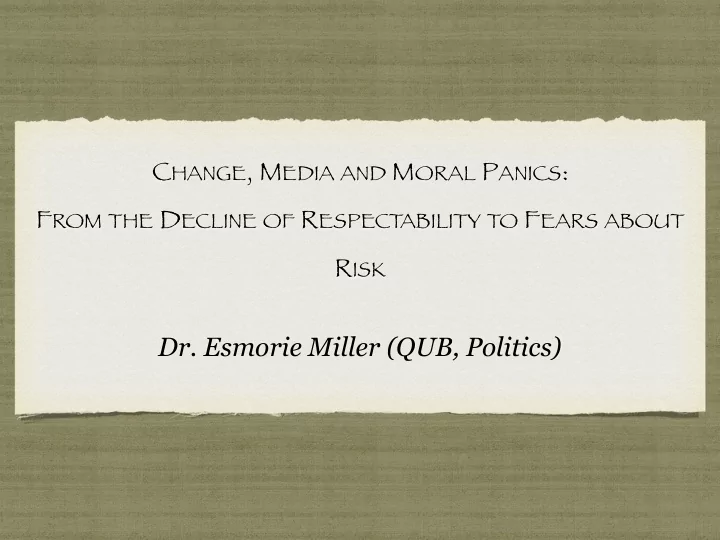

C HANGE , M EDIA AND M ORAL P ANICS : F ROM THE D ECLINE OF R ESPECTABILITY TO F EARS ABOUT R ISK Dr. Esmorie Miller (QUB, Politics)
INTRODUCTION • The role the media in society’s changing perceptions of youth and deviance - This role is important b/c it contributes to youths’ inclusion and exclusion • I am concerned here with two prominent chronological examples: (i) an older, some would say outdated, idea about youths’ defiance of the deferential order (ii) and the contemporary concerns with the idea that youths’ deviance poses a multitude of risks, including harm •Sociologist Stanley Cohen’s moral panic model: used here as a tool to provide some insights into why I regard this change, particularly the media’s role, as important
THREE AIMS FOR THIS PRESENTATION 1) Outlining sociologist Stanley Cohen’s belief in the idea that the media plays a crucial role in defining youth’s deviance 2) Criticisms of the model: terms ‘moral’ and ‘panic’ convey the impression that concerns felt by society are ‘irrational’ ‘hysterical’ ‘unfounded’ and without basis 3) Using recognition theory to affirm Cohen’s model - The media has been crucial, especially in contemporary society, in marking moral perimeters - Results of media narrative: inclusion or exclusion of youth - I propose: inclusion and exclusion is in large part due to the element of ‘panic’ characterising contemporary society’s concerns about youth and deviance - But it is, also, due to the element of ‘moral’ that has been attributed to the ‘panic’
STRUGGLE FOR RECOGNITION Introducing Axel Honneth’s Theory of recognition to the discussion Main insight: Cohen’s ‘moral panic’ does not characterise society’s reaction as irrational, hysterical, or without basis Within recognition framework we get an insight into importance of ideas defined by, or in, the media, like agency, i n d i v i d u a l a u t o n o m y, s o c i a l responsibility, inclusion, exclusion, etc.
RECOGNITION THEORY Axel Honneth theorised in (1992) that: Social recognition important contributor to the individual’s self realisation Important determinant to the individual’s place within society
BACKGROUND: MORAL PANIC (1) ‘A condition, episode, person or group of persons’ who emerge ‘to become defined as a threat to societal values and interests’ - Stanley Cohen, 2002 [1972], p.1 (From Folk Devils and Moral Panics)
BACKGROUND: MORAL PANIC (2) Careful Characterisation of Moral Panic Idea NOT : • ‘a stimulus (media message) and response (audience behaviour) But: • p o i n t s a t w h i c h m o r a l awareness is raised • (‘defining deviance up’) or ( ‘ d e f i n i n g d e v i a n c e down’)’ (Cohen, 2002, xxix).
EXAMPLE (1): DEFERENCE • Prescribed social conduct: hierarchies, focused on manners and respectability - Popular Associations: Dickensian Youth & Monarchy - Social differentiation: Lords and ladies vs. Working class - Please sir could I have some more?!
1960S: DEFERENTIAL ORDER CHALLENGED Media’s point of moral Awareness = challenge to moral underpinnings of the social order
RISK CONTINUED Associated with modernity - No more expectation to reproduce the past - Industrialisation and technology = uncertain future = Benefits and burdens
RISK CONTINUED Two Major Theoretical Explanations - This is about ‘…a society increasingly preoccupied with the future (and also with safety), which generates the notion of risk’ (Antony Giddens, 1998, p.209). - This is ‘…a systematic way of dealing with hazards and insecurities induced and introduced by modernisation itself’ (Ulrich Beck, 1992, p.21).
IMAGES: (1) THE ABANDONED CITY OF PRIPYAT(UKRAINE) WITH CHERNOBYL PLANT IN THE DISTANCE: AND (2), THE CHALLENGER SPACE SHUTTLE, BEFORE IT EXPLODED (1986) AFTER LIFT OFF PROMINENT MODERN DISASTERS
INNER-CITY YOUTH Inner-city Youth
QUOTES FROM THE FIELD London Social Worker : ’That’s what I call geographical stereotyping. Because these young people live in this area and the police know that there is criminality and gang activity in this area they try to rub everybody with the same brush. Whether you belong to a gang, whether you are involved in criminal activity or not you are all in the same pot’ (Interview Data: 9 December 2011). Toronto Police Officer : ’When a crime happens what we hear is male, black, baggy blue jeans. This is very general. So we stop each group of black kids we see and question them asking about their criminal history’ (Interview Data: 2 October 2011).
RECOGNITION THEORY • One Main insight: in introducing Axel Honneth’s Theory of recognition to the discussion, is that • Cohen’s ‘moral panic’ model does more than equate society’s reaction to inner-city gang crime to irrationality and hysteria - In Honneth’s theory socialisation within the family is key to how individuals develop their self confidence and thereby their sense of wider social responsibility - This implies that the inner-city youth lack the moral fortitude to be socially responsible
CONCLUSION • In this sense, Cohen’s moral panic framework is proposed here to have remained relevant as an analytical tool - It still highlights the relevance of the media in defining youths’ deviance - What we should see in the inner-city youth gang example, is that the media continues to negotiate moral awareness in concerns about youths’ activities - They draw parallels, between youths’ family life and their potential (or lack of potential) as moral beings - This is consistent with the media’s treatment of the Mods and Rockers - In both cases, the media selected and presented ideas about youth, relaying a conception of youth which defined them as a active agents, whose activities threatened interests that were inherently socially - In the end, these portrayals are considered a moral panic because they are based on authoritative stereotypes, which are disproportionate to reality
Recommend
More recommend